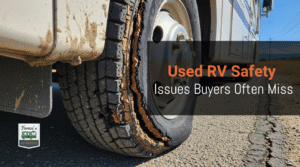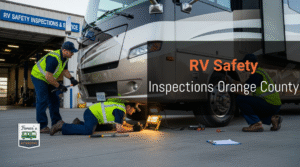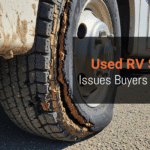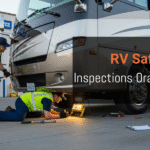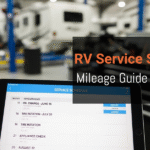Storing your RV, trailer, or van during the off-season can seem daunting, but it doesn’t have to be. Taking proper care of your recreational vehicle while in storage can significantly extend its lifespan and save you money on repairs later. By following a few simple best practices, you can ensure your vehicle remains in excellent condition and is ready for your next adventure.
One important step is to clean your RV thoroughly, both inside and out. Remove any food items to avoid attracting pests and make sure to check for leaks or any needed repairs. Covering your vehicle with a breathable tarp can also protect it from harsh weather conditions. Regular inspections will keep you informed about any issues that may arise while in storage.
Additionally, consider using a secure storage facility that offers features like gated entry and surveillance cameras. This ensures that your RV, trailer, or van is safe from theft or vandalism. By implementing these practices, you can enjoy peace of mind knowing your vehicle is well cared for until you hit the road again.
Choosing The Right Storage Location
Selecting the ideal storage location for your RV is crucial for its protection and longevity. Whether you prefer indoor or outdoor storage, it’s important to consider factors such as California’s coastal climate and essential security features.
Indoor Vs Outdoor Storage: Pros And Cons
When deciding between indoor and outdoor RV storage, weigh the pros and cons. Indoor storage offers a climate-controlled environment that protects your RV from harsh weather, vandalism, and theft. You can find indoor RV storage units at many facilities, which often provide extra protection for your vehicle.
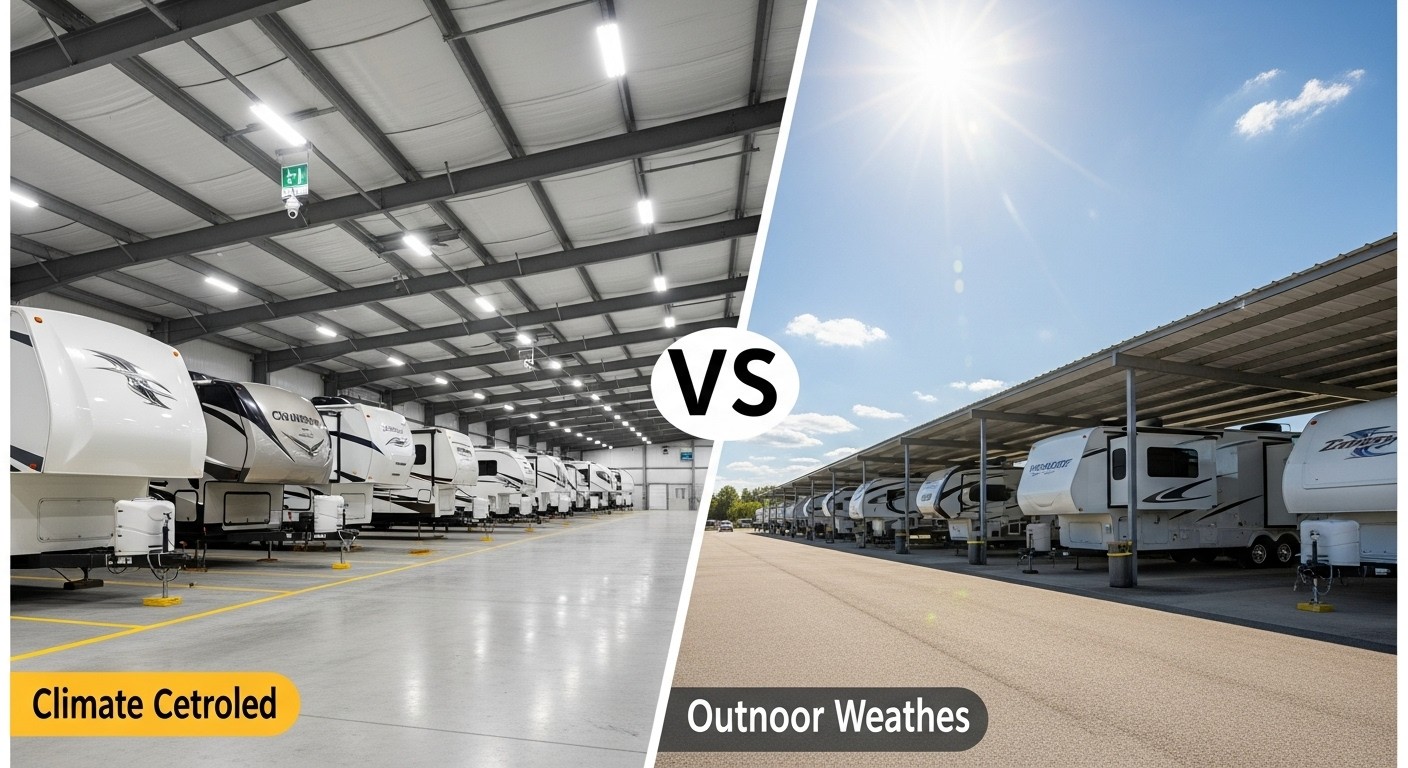
Outdoor storage, on the other hand, is usually more affordable and may provide covered storage options that shield your RV from direct exposure to sun and rain. While outdoor storage is convenient, your RV may still be exposed to the elements, which can lead to wear and tear over time. Ultimately, your choice will depend on your budget and the level of protection you desire.
Considerations For California’s Coastal Climate
California’s coastal climate can be challenging for RV storage. The salty air can lead to rust and corrosion on metal parts. Therefore, selecting a facility that offers indoor RV storage or climate-controlled RV storage is wise. A climate-controlled environment regulates temperature and humidity levels, preventing damage caused by moisture.
Make sure the storage area is elevated to avoid water pooling, especially during the rainy season. Additionally, using protective covers designed for RVs can help mitigate damage from sun and salt exposure. Assess the geographical location and choose a facility that’s not just accessible but also mindful of these specific coastal challenges.
Security Features To Look For
Safety should be a top priority when choosing a storage facility for your RV. Look for security features such as video surveillance and well-lit areas to deter theft and vandalism. Facilities with electronic gate access provide an extra layer of protection, ensuring only authorized individuals can enter.
Check if the facility has on-site property managers who can monitor activities. Covered storage options can also shield your RV from prying eyes while protecting it from the elements. Choosing a storage facility with strong security measures will give you peace of mind, knowing that your RV is safe when not in use.
Preparing Your RV Exterior For Storage
Taking care of your RV’s exterior is vital for keeping it in great shape during storage. This includes washing, sealing, and protecting it against various weather elements. By focusing on these areas, you can prevent damage and ensure your RV stays ready for your next adventure.
Wash And Wax To Prevent Corrosion
Begin by thoroughly washing your RV. Use a gentle cleanser designed for RVs to remove dirt, grime, and any deposits that may cause corrosion. Pay attention to the wheel wells and undercarriage, as these areas can harbor moisture and dirt.
After washing, apply a high-quality wax. This adds a protective layer that helps shield against UV rays and prevents oxidation. Waxing not only enhances your RV’s shine but also makes it easier to clean in the future. Remember to reapply wax every few months, especially if your RV is parked outside.
Inspect And Seal Roof, Windows, And Seams
Next, inspect the roof, windows, and seams for any damage. Look for cracks, gaps, or worn areas that could allow water to enter. Use a sealant that is specific to RVs for any gaps you find. Proper sealing helps prevent leaks that can damage the interior of your RV.
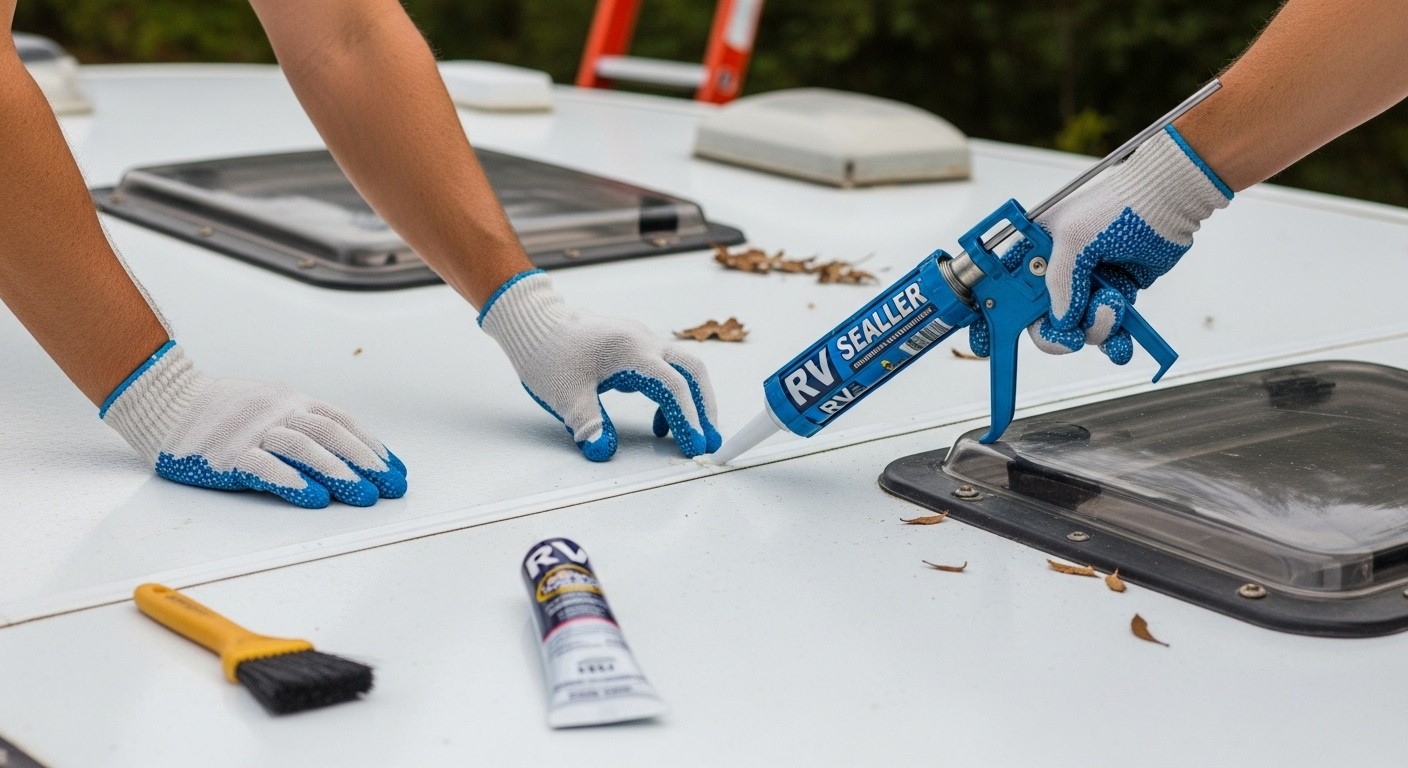
Don’t forget to clean the roof as well. Remove debris, leaves, and other material that can hold moisture. Keeping the surface clean will help extend the life of the roofing material and prevent mold growth. Regular inspections are key for maintaining the integrity of your RV.
Covering Your RV: Tarp Vs Custom RV Cover
Finally, consider how to cover your RV for storage. You can choose between a tarpaulin or a custom RV cover. A tarp is usually cheaper but may not provide the same level of protection. It can also trap moisture underneath, leading to mold.
A custom RV cover is designed specifically for your vehicle and offers better fit and protection against UV rays and weather elements. Look for covers with ventilation to reduce condensation. Investing in a good cover will pay off by protecting your RV and extending its lifespan.
Protecting Internal Systems And Appliances
To keep your RV in top shape while in storage, special care is needed for the internal systems and appliances. Proper winterization, along with cleaning, ensures that everything functions smoothly when you’re ready to hit the road again.
Draining Water Tanks And Lines (Winterization)
Start by draining the fresh water tank and all water lines. This step is vital to prevent freezing and potential cracks in your plumbing. Open all faucets and the low-point drains to allow any remaining water to flow out completely. After draining, consider using RV antifreeze in the system. This is safe for your plumbing and helps protect against freezing temperatures. Make sure to follow the manufacturer’s guidelines for the appropriate amount of antifreeze to use.
Flushing And Sanitizing The Plumbing System
Once you’ve drained the tanks, it’s time to flush and sanitize the plumbing system. Create a sanitizing solution using unscented household bleach and water. Mix 1/4 cup of bleach per gallon of water. Pour this solution into the fresh water tank and fill it to capacity. Open all faucets and let the mixture circulate through the entire system, ensuring that all fixtures receive treatment. Let it sit for several hours before flushing the system with fresh water. This helps eliminate bacteria and odors, making it safe for your next trip.
Preparing The Fridge, Stove, And HVAC Systems
Prepare your RV’s refrigerator, stove, and HVAC systems for storage to maintain their longevity. For the fridge, unplug it and leave the door open to prevent mold growth. Clean and remove any food items. For the stove, ensure all burners are clean, and check for any signs of grease buildup. Wipe down surfaces and leave the stove’s lid open to keep it fresh. Lastly, inspect the HVAC system. Replace filters, clear any debris around the unit, and cover outdoor components to protect them from weather damage. Proper preparation now can save you from costly repairs later.
Battery And Electrical System Maintenance
Maintaining your RV’s battery and electrical system is crucial for performance and longevity. Proper care minimizes issues when you’re ready to hit the road again after storage.
Disconnect Or Remove The Battery
Disconnecting or removing the battery is an essential step in protecting it during storage. When a battery is left connected, small electrical draws can drain its charge over time. To prevent this, either disconnect the negative terminal or completely remove the battery.
If you choose to remove the battery, store it in a cool, dry location. Ensure it is charged before storage. Regularly check the battery terminal connections for corrosion, and clean them if needed. This helps maintain a strong connection when you reconnect.
Trickle Charging And Battery Storage Tips
Using a trickle charger can help keep your battery in optimal condition during storage. This device provides a low, steady charge to prevent battery drain. Make sure to select a charger compatible with your battery type.
Place the charger in a safe area, and connect it according to the manufacturer’s instructions. Monitor the charger regularly to ensure it’s working properly. It’s also helpful to check your battery’s water levels, especially for lead-acid batteries. Top them off with distilled water if necessary.
Inspecting And Disconnecting Electronics
Before storing your RV, inspect electronic devices to avoid battery drain. Turn off all unnecessary electronics, and disconnect those that draw power even when off.
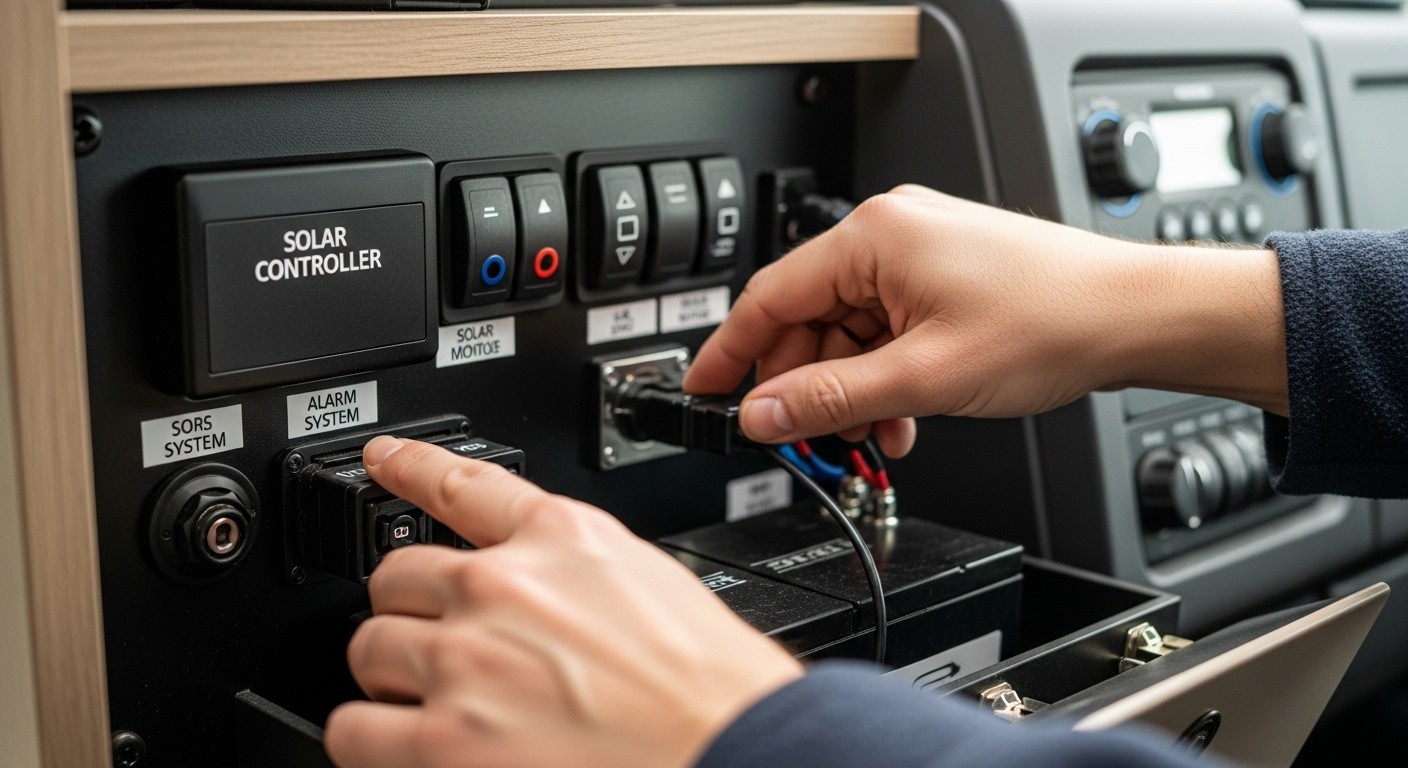
List devices such as solar controllers and alarms that might still use power. By disconnecting these, you minimize battery drain while in storage. If you have any devices with remote control capabilities, ensure they are turned off completely.
Regular inspections of your RV’s electrical system help identify any potential issues. Keeping your electrical components in good working order makes for a smoother start when you’re ready for your next adventure.
Tire And Chassis Care During Storage
Proper care of your RV’s tires and chassis during storage is essential to ensure safe travels when you’re ready to hit the road again. Taking preventive measures will help maintain the integrity and longevity of these crucial components.
Inflate Tires Properly And Prevent Flat Spots
Before storing your RV, inflate your tires to the manufacturer’s recommended pressure. Under-inflated tires can lead to flat spots, which can cause damage over time. Check the pressure regularly, even while in storage, as temperature fluctuations can affect tire pressure. A good practice is to move your RV slightly every few weeks, allowing the tires to rotate and helping prevent flat spots. You may also consider using wheel chocks to keep your RV stationary during storage without stressing the tires.
Use Of Tire Covers For UV Protection
To protect your tires from sun damage, invest in high-quality tire covers. UV rays can cause the rubber to crack and degrade, leading to premature tire failure. Choose covers that are breathable to prevent moisture buildup, which can also harm your tires. Make sure the covers fit snugly and securely. When you are ready to use your RV again, remove the covers and inspect the tires for any signs of wear or damage that may have occurred during storage.
Consider Using Jack Stands Or Wheel Blocks
Using jack stands or wheel blocks can be very beneficial during storage. Jack stands relieve some weight from the tires, helping to prevent flat spots. Wheel blocks can also stabilize your RV and provide added safety. If you choose to use jack stands, ensure they are positioned according to the RV manufacturer’s guidelines. This can help maintain the chassis alignment and let the tires rest comfortably. Regularly check the support points for rust or damage during storage to ensure everything remains secure.
Interior Protection And Pest Prevention
Keeping your RV safe and clean while in storage is key to avoiding costly damage. Focus on cleaning thoroughly, maintaining proper ventilation, and preventing pest infestations to ensure your recreational vehicle stays in top shape.
Deep Clean And Declutter The Interior
Start by removing all items from inside your RV. This includes food, clothing, and personal belongings. Check every nook and cranny for hidden items.
Once emptied, deep clean all surfaces. Use a vacuum with a HEPA filter to remove dirt, dust, and allergens. Wipe down surfaces with a gentle cleaner, paying special attention to kitchen and bathroom areas where moisture can linger.
After cleaning, consider using storage bins for items you plan to keep in the RV. This helps reduce clutter and protects them from potential pests. Make sure to label the bins for easier access in the future.
Use Of Moisture Absorbers And Ventilation
Proper ventilation is essential for preventing mold and mildew during storage. Open windows slightly or use vents to allow air to flow. This will help reduce humidity levels inside your RV.
Consider placing moisture absorbers, such as silica gel packs or specific RV dehumidifiers, to combat excess moisture. These products are effective at absorbing humidity and can reduce the risk of damage.
Regularly check your RV’s internal environment. If you notice any signs of moisture or musty smells, take action immediately. Proper ventilation and moisture management will protect your investment.
Preventing Rodent And Insect Infestation
Pest infestations can cause serious damage to your RV. Start by sealing any openings. Check for gaps around windows, doors, and even in the undercarriage. Use caulk or foam to fill these spaces.
Next, store food items in airtight containers to deter pests. Empty all cabinets and clean them thoroughly. A vacuum can remove crumbs and food residue that attract insects.
To prevent rodents, consider setting traps or using natural repellents. Place these strategically around your RV. Regularly inspect for signs of pests, such as droppings or nests, and act quickly if you find any, ensuring a pest-free storage experience.
Documentation And Insurance Readiness
Ensuring your RV is properly documented and insured is vital for a hassle-free off-season. Staying organized can save you time and stress when you’re ready to hit the road again. Focus on three key areas: registration and insurance, maintenance records, and service intervals.
Update Registration And Insurance Coverage
Before storing your RV, make sure your registration and insurance are current. Check your local Department of Motor Vehicles (DMV) for registration requirements. This may include renewing your registration if it’s set to expire during the winter months.
Review your insurance policy as well. Confirm that your coverage is appropriate for off-season storage. Some providers offer specialized winter storage insurance, which can save you money. Keep proof of your insurance nearby in case you need it.
Store Copies Of Maintenance And Service Records
Keeping track of your RV’s maintenance is essential. Store copies of all service records in a dedicated folder. This includes oil changes, tire rotations, and any repairs made.
Having these documents organized helps you stay on schedule for future service. Additionally, they can be beneficial if you decide to sell your RV. Prospective buyers appreciate detailed maintenance histories, as it shows that you have taken good care of the vehicle.
Note Service Intervals For Spring Start-Up
As winter storage ends, it’s important to have a plan for service intervals. Mark your calendar with dates for necessary maintenance tasks. This could include battery checks, tire inflation, and fluid levels.
Create a checklist of these tasks to ensure you don’t miss anything. This plan will help you start the season smoothly. By staying ahead of maintenance needs, you enhance the longevity of your RV and ensure safety on the road.
Periodic Checks During The Storage Period
Regular checks during the storage period are essential to prevent issues and maintain your RV’s condition. By staying proactive, you can ensure your vehicle is secure and ready for use when the season changes.
Monthly Walkaround And Visual Inspection
Each month, walk around your RV to check for any signs of damage or wear. Focus on the following areas:
- Body and Exterior: Look for cracks, dents, or scratches. Identifying problems early can save you from costly repairs later.
- Windows and Seals: Inspect window seals for leaks or wear. Ensure they remain intact to prevent water damage.
- Underneath: Check for signs of rust, leaks, or pests. Addressing any issues quickly is key to preserving your RV.
Document any findings, and don’t hesitate to take action if you notice anything unusual. This step is crucial in keeping your RV in top shape.
Ventilation And Air Circulation Routine
Ensure proper ventilation to prevent mold and mildew inside your RV. Here are some steps to follow:
- Open Vents: Keep roof vents slightly open when possible. This allows air to circulate even in storage.
- Use Absorbent Materials: Place moisture-absorbing products inside. Silica gel packs or desiccants can reduce humidity.
- Inspect Indoor Areas: Regularly check for damp spots or musty odors. Address any moisture problems immediately to protect your RV’s interior.
By maintaining good air circulation, you help keep your RV’s interior fresh and mold-free.
Battery And Tire Status Check
Check the status of your RV’s battery and tires to keep everything operational. Here’s how to do it:
- Battery Maintenance: Inspect connections for corrosion. Clean any buildup and check the water levels if your battery is not maintenance-free. Consider using a trickle charger if the battery will be stored for a long time.
- Tire Condition: Inspect tires for wear and proper inflation. Tires can lose air over time, leading to flat spots. Inflate them to the recommended pressure.
Performing these checks not only helps maintain your RV but also ensures a safer driving experience when you’re ready to hit the road again.
When To Call The Experts: Getting Help From Farace Automotive & R.V. Center
Taking care of your RV during the off-season is crucial for its longevity and performance. You may find it beneficial to call in the experts for specific tasks. Here are some times when seeking help is a wise choice.
Pre-Storage Inspection And Servicing
Scheduling a pre-storage inspection is essential. It helps catch any potential issues before storing your RV. During this service, technicians will assess the overall condition of your vehicle.
This includes checking for leaks, corrosion, and wear. They will also inspect the tires, brakes, and other critical systems. Addressing these concerns early can save you from costly repairs later. You will receive a detailed report on what needs attention. Make sure to document any recommendations for future reference.
Winterization And De-Winterization Packages
Winterization is key to protecting your RV during cold months. If you’re unsure about the process, take advantage of the winterization packages offered by Farace Automotive & R.V. Center.
This service includes draining the water system and adding antifreeze, preventing damage to pipes and tanks. During spring, the de-winterization package prepares your RV for use. It involves flushing out antifreeze and checking systems to ensure everything works properly. These packages take the guesswork out of seasonal storage, providing you peace of mind.
Custom Storage Advice Based On RV Type
Each RV type has unique care needs. At Farace Automotive & R.V. Center, you will receive custom storage advice tailored to your specific vehicle.
Whether you have a Class A motorhome, a travel trailer, or a fifth wheel, expert guidance will enhance your RV’s longevity. You can discuss your RV’s requirements for maintenance, tire care, and battery storage. Tailored advice ensures that you’re doing everything necessary for optimal storage and protection. Always consult the experts for recommendations based on your RV model.



